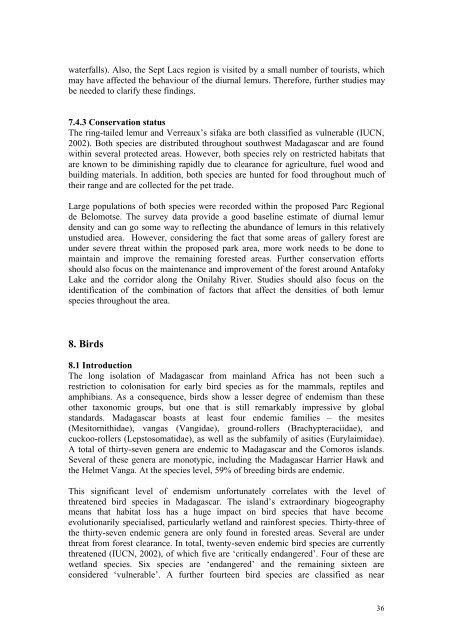The proposed Parc Regional de Belomotse - Frontier-publications ...
The proposed Parc Regional de Belomotse - Frontier-publications ...
The proposed Parc Regional de Belomotse - Frontier-publications ...
You also want an ePaper? Increase the reach of your titles
YUMPU automatically turns print PDFs into web optimized ePapers that Google loves.
waterfalls). Also, the Sept Lacs region is visited by a small number of tourists, which<br />
may have affected the behaviour of the diurnal lemurs. <strong>The</strong>refore, further studies may<br />
be nee<strong>de</strong>d to clarify these findings.<br />
7.4.3 Conservation status<br />
<strong>The</strong> ring-tailed lemur and Verreaux’s sifaka are both classified as vulnerable (IUCN,<br />
2002). Both species are distributed throughout southwest Madagascar and are found<br />
within several protected areas. However, both species rely on restricted habitats that<br />
are known to be diminishing rapidly due to clearance for agriculture, fuel wood and<br />
building materials. In addition, both species are hunted for food throughout much of<br />
their range and are collected for the pet tra<strong>de</strong>.<br />
Large populations of both species were recor<strong>de</strong>d within the <strong>proposed</strong> <strong>Parc</strong> <strong>Regional</strong><br />
<strong>de</strong> <strong>Belomotse</strong>. <strong>The</strong> survey data provi<strong>de</strong> a good baseline estimate of diurnal lemur<br />
<strong>de</strong>nsity and can go some way to reflecting the abundance of lemurs in this relatively<br />
unstudied area. However, consi<strong>de</strong>ring the fact that some areas of gallery forest are<br />
un<strong>de</strong>r severe threat within the <strong>proposed</strong> park area, more work needs to be done to<br />
maintain and improve the remaining forested areas. Further conservation efforts<br />
should also focus on the maintenance and improvement of the forest around Antafoky<br />
Lake and the corridor along the Onilahy River. Studies should also focus on the<br />
i<strong>de</strong>ntification of the combination of factors that affect the <strong>de</strong>nsities of both lemur<br />
species throughout the area.<br />
8. Birds<br />
8.1 Introduction<br />
<strong>The</strong> long isolation of Madagascar from mainland Africa has not been such a<br />
restriction to colonisation for early bird species as for the mammals, reptiles and<br />
amphibians. As a consequence, birds show a lesser <strong>de</strong>gree of en<strong>de</strong>mism than these<br />
other taxonomic groups, but one that is still remarkably impressive by global<br />
standards. Madagascar boasts at least four en<strong>de</strong>mic families – the mesites<br />
(Mesitornithidae), vangas (Vangidae), ground-rollers (Brachypteraciidae), and<br />
cuckoo-rollers (Lepstosomatidae), as well as the subfamily of asities (Eurylaimidae).<br />
A total of thirty-seven genera are en<strong>de</strong>mic to Madagascar and the Comoros islands.<br />
Several of these genera are monotypic, including the Madagascar Harrier Hawk and<br />
the Helmet Vanga. At the species level, 59% of breeding birds are en<strong>de</strong>mic.<br />
This significant level of en<strong>de</strong>mism unfortunately correlates with the level of<br />
threatened bird species in Madagascar. <strong>The</strong> island’s extraordinary biogeography<br />
means that habitat loss has a huge impact on bird species that have become<br />
evolutionarily specialised, particularly wetland and rainforest species. Thirty-three of<br />
the thirty-seven en<strong>de</strong>mic genera are only found in forested areas. Several are un<strong>de</strong>r<br />
threat from forest clearance. In total, twenty-seven en<strong>de</strong>mic bird species are currently<br />
threatened (IUCN, 2002), of which five are ‘critically endangered’. Four of these are<br />
wetland species. Six species are ‘endangered’ and the remaining sixteen are<br />
consi<strong>de</strong>red ‘vulnerable’. A further fourteen bird species are classified as near<br />
36
















